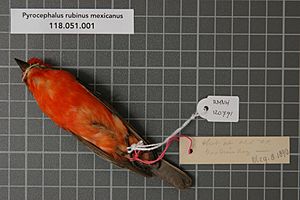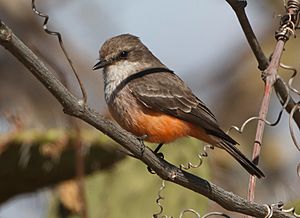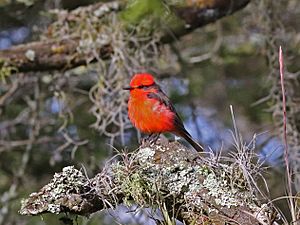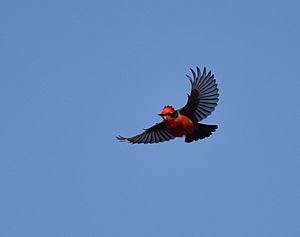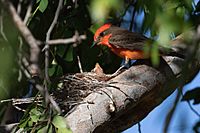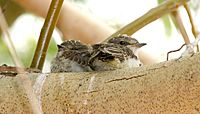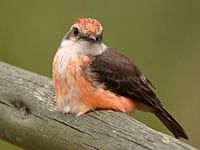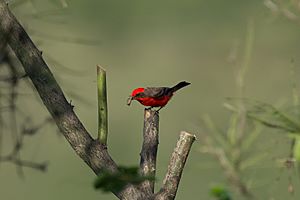Vermilion flycatcher facts for kids
Quick facts for kids Vermilion flycatcher |
|
|---|---|
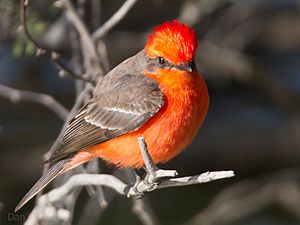 |
|
| Conservation status | |
| Scientific classification | |
| Genus: |
Pyrocephalus
|
| Species: |
obscurus
|
| Subspecies | |
|
See text |
|
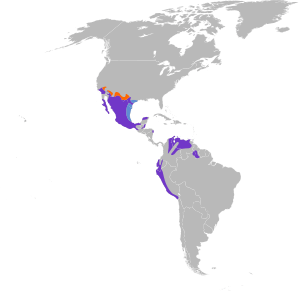 |
|
| Range map
Year-round Breeding Nonbreeding |
|
The vermilion flycatcher (Pyrocephalus obscurus) is a small, bright red bird. It belongs to the tyrant flycatcher family. You can find it in South America and southern North America. Unlike many birds in its family, it has a very bright, striking red color.
Male vermilion flycatchers have bright red heads, chests, and bellies. Their wings and tails are brownish. Females do not have this bright red color. They are harder to spot and might look like the Say's phoebe.
The vermilion flycatcher's song sounds like pit pit pit pidddrrrreeedrr. This song helps males claim their territory. These birds like to live near water, in areas with trees and open spaces. They are insectivores, meaning they eat insects. They catch their food while flying. They also shed their feathers, a process called molt, which starts in summer.
Vermilion flycatchers usually stay with one partner, which is called being socially monogamous. However, they sometimes mate with other birds. Females also practice a special trick called brood parasitism. This is when they lay their eggs in another bird's nest. Females build shallow, open nests. They sit on the whitish eggs, which have brown spots. The male brings food to the female while she is on the nest. They usually lay two or three eggs twice a season, from March to June. After the chicks hatch, both parents feed them. The young birds are ready to fledge (leave the nest) after about 15 days.
This bird was first described in the late 1830s. This happened after Charles Darwin's famous voyages. In 2016, scientists studied the Pyrocephalus group of birds again. They found several new species that used to be considered types of vermilion flycatchers. One of these new species, the San Cristóbal flycatcher, is now extinct. The number of vermilion flycatchers has gone down because of habitat loss. However, there are still millions of them. Because of this, the International Union for the Conservation of Nature says it is a species of least concern. This means it is not in danger of extinction right now.
Contents
About the Vermilion Flycatcher
The tyrant flycatcher family, Tyrannidae, only lives in the Americas. Most birds in this family are not very colorful. But the vermilion flycatcher is a bright exception!
The name Pyrocephalus comes from Greek words. It means "fire head" or "flame headed." The second part of its scientific name, obscurus, is Latin. It means "dark" or "dusky." The common name "vermilion flycatcher" describes its bright color and its diet of insects.
Different Kinds of Vermilion Flycatchers
Before 2016, scientists thought there were 11 to 13 different types (subspecies) of vermilion flycatchers. A study in 2016 changed this. Now, there are nine widely recognized subspecies. Some of the old subspecies are now considered their own separate species. These include the Darwin's flycatcher, San Cristóbal flycatcher, and scarlet flycatcher.
These different types of vermilion flycatchers mostly vary in color. The males' red feathers can be slightly different shades. The females' gray feathers and belly colors also vary. The vermilion flycatcher likely first appeared about 1.15 million years ago.
What the Vermilion Flycatcher Looks Like
The vermilion flycatcher is a small bird. It is about 13 to 14 centimeters (5 to 5.5 inches) long. Its wingspan is about 24 to 25 centimeters (9.4 to 9.8 inches). It weighs between 11 and 14 grams (0.39 to 0.49 ounces).
Male and female birds look very different. This is called sexual dimorphism. Males are bright red with dark brown feathers on their back, wings, and tail. The red color can be vermilion, scarlet, or orangish. Females have a grayish head, wings, and tail. Their belly starts white and becomes light red lower down. Young birds look similar to adult females. Young males have brighter red bellies. Young females have yellowish bellies.
Vermilion flycatchers shed their old feathers and grow new ones. This process is called molting. It takes about 62 to 79 days. It usually starts in July and ends in September. Many birds molt after they fly to warmer places for winter. Molting is slow for these birds. This is because they need to fly well to catch insects.
How Vermilion Flycatchers Communicate
Male vermilion flycatchers sing from a perch. Their song sounds like pit pit pit pidddrrrreedrr. They also have a flight song they sing high in the sky. This sounds like pt-pt-pre-ee-een. They also make other noises, like a pees call or a peent noise while looking for food. Females might make a tjee-tjee-tjee call before mating.
The male's song is very important. It helps him claim his territory. Males can change their song to show different things. The first part of the song gets longer after they build a nest. It also gets longer before sunrise. This part of the song tells other birds how strong the male is. It also shows how much he will defend his territory. Females usually do not sing.
Loud city noise can affect their songs. Birds in Mexico City were found to sing louder and longer songs when it was noisy. They do not sing all year. In places like Arizona and Texas, they sing from late February to July.
Besides singing, they also make non-vocal sounds. Males snap their beaks between songs. Females snap their beaks while watching males fly during courtship. They can also make a whirring noise with their wings. This happens when they hop between perches or show off their territory.
Where Vermilion Flycatchers Live
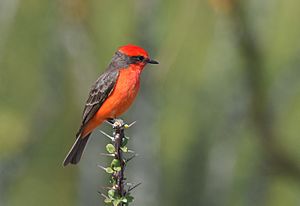
Vermilion flycatchers live in most of Mexico. Their range goes north into the southwestern United States. It also goes south into parts of Central America and South America. They have even been seen as far north as Canada.
Birds in North America usually stay in one place all year. They only move if they are at the very edge of their range. Birds in South America, especially those further south, might fly long distances. They can fly up to 4,000 kilometers (2,500 miles) to warmer areas for winter. They like to spend winter in places where the temperature stays above -1°C (30°F). North American birds usually fly south by late August. They return between February and April. Their ability to fly long distances helped them spread across the Americas.
These birds like open areas. You can find them in trees or bushes in savannas, scrublands, and farms. They also live in areas near water, like riparian woodlands, and deserts. They can live at high places, up to 3,000 meters (9,800 feet) high. In Arizona, they prefer to breed in cottonwood or mesquite trees. They especially like Goodding's willow for nesting.
How Vermilion Flycatchers Behave
Vermilion flycatchers are usually alone. Sometimes, in winter, they might form small groups of up to five birds. They spend most of their time sitting on tree branches. They only land on the ground rarely to catch insects. They prefer to fly rather than hop to move around. They do not glide very often.
Reproduction and Nesting
Vermilion flycatchers are usually socially monogamous. This means they mostly stay with one partner. But both males and females might also mate with other birds. During breeding season, males claim and protect their territory. To defend their space, males raise their head feathers and fan out their tail. They also pump their tail up and down and snap their beak. Males will chase other males out of their territory. If there are baby birds, they will also chase away other bird species.
To attract a female, the male fluffs up his head and chest feathers. He fans his tail and flies in a fluttery way while singing.
The male chooses a place for the nest. Then, the female starts building it. The vermilion flycatcher's nest is a shallow cup. It is made of small twigs and soft materials. The inside is lined with feathers. The edge of the nest is often covered with lichen. They might use spiderwebs to hold the nest together. The female shapes the nest by rocking her body. She keeps adding soft materials like plant parts, hair, fur, or even string.
Nests are usually about 64 to 76 millimeters (2.5 to 3 inches) wide. They are about 25 to 51 millimeters (1 to 2 inches) tall. The cup part is less than 25 millimeters (1 inch) deep. Nests are usually placed in a tree branch fork, less than 2 meters (6 feet) off the ground. About 12% of nests are used again. Old nests might be taken apart to get materials for new ones.
Females start laying eggs in March and continue until June. They lay one egg each day in the early morning. The eggs are oval-shaped. They are about 17 millimeters (0.67 inches) long and 13 millimeters (0.51 inches) wide. Each egg weighs about 1.6 grams (0.056 ounces). This is about 11% of the female's body weight. The eggs are a dull whitish color. They have large brown spots in a circle pattern on the wider end. The color and spots can vary.
A group of eggs, called a clutch, usually has two or three eggs. Sometimes, it can have up to four. The female alone sits on the eggs to keep them warm. This takes 13 to 15 days. The male brings food to the female while she is on the nest. She never asks for food. Sometimes, after he feeds her, they will mate. The female is very careful with the nest.
The young birds are altricial. This means they are helpless when they hatch. Both parents feed the chicks. The male might take care of the young birds that have left the nest. This allows the female to build another nest. Nests can be reused in the same season, but it is not common. One study found that only 12% of nests were reused. This only happened if the nest had successfully raised young before. Reusing nests saves time and energy. However, it might also mean more parasites.
The baby birds open their eyes four days after hatching. They are ready to leave the nest 15 days after hatching. All the young usually leave the nest on the same day. If the nest is disturbed, chicks older than 11 days will leave early. Vermilion flycatchers usually have two groups of babies per year. Sometimes, they can have three.
What Vermilion Flycatchers Eat
The vermilion flycatcher mainly eats insects. These include flies, grasshoppers, and beetles. They usually catch insects in the air. They fly out from a perch, catch the insect, and return. They are opportunistic eaters. This means they eat whatever food is available. They have even been seen eating small fish. They do not eat plants. They might also eat bees.
They spit out parts of insects they cannot digest as pellets. While waiting for insects, they sit on thin branches. They pump their tail up and down. They spend about 90% of their day perching. Only 4–11% of their day is spent chasing food. Once they see an insect, they jump from their perch and chase it. If they miss an insect the first time, they can fly very quickly to catch it. Once caught, they might hit the insect before swallowing it whole. Sometimes, they catch insects on the ground. Most prey is caught within 3 meters (10 feet) of the ground. They rarely catch food over water.
Survival of the Vermilion Flycatcher
Scientists do not know much about what eats vermilion flycatchers. There have been rare reports of a scrub-jay eating them. Also, a group of live baby birds in a nest were eaten by fire ants. The oldest known vermilion flycatcher lived to be five and a half years old. But there is not much information about how long they live or what causes them to die.
A study in Texas found that between 59% and 80% of eggs laid successfully became young birds that left the nest. Half of the nests that failed had eggs, and half had young birds. Nests failed because birds left them or the eggs were not fertile. A similar study in Ecuador showed success rates from 20% to 59%.
Some tiny creatures, called ectoparasites, live on the outside of these birds. Dermanyssus mites are common. A study in 2008 found that mites did not greatly affect how many baby birds survived. Even nests with many mites successfully raised young. Meanwhile, nearby nests without mites did not raise any young. Flies might also lay their eggs in nests. This gives a home to their larva.
Diseases of the vermilion flycatcher are not well studied. However, diseases of birds on the Galapagos Islands are known. These diseases might have affected the San Cristóbal flycatcher, which is related to the vermilion flycatcher. Diseases like avian malaria and avian pox viruses might have caused the extinction of the San Cristóbal flycatcher.
Vermilion Flycatchers and Humans
Birdwatchers love the vermilion flycatcher. But people do not usually keep them as pets. This is because the males tend to lose their bright red color when kept in cages. This likely happens because of their diet. To stay bright red, birds need to eat a lot of yellow chemicals called zeaxanthin. Their bodies then turn these into red color. A bright male bird shows that he is healthy and good at finding food. This helps him attract mates.
The Audubon Society in Tucson, Arizona, publishes a magazine named after the vermilion flycatcher.
Conservation Status
The vermilion flycatcher lives in a very large area. There are also many of them, estimated to be between 5 million and 50 million birds. Because of this, the International Union for the Conservation of Nature lists it as a species of least concern. This means it is not currently in danger of extinction.
However, the total number of these birds is going down. Between 1966 and 2007, their numbers dropped by about 1.7% each year. In Texas, the numbers are dropping faster, by 2.6% per year. They used to be common in southern California but are now rare there. But they are spreading into new areas like Florida and Oklahoma. In Arizona, their numbers are increasing by 2.2% per year.
Vermilion flycatchers have learned to live near humans. They are nesting more often in parks and golf courses. But this might also mean more brown-headed cowbirds. These birds lay their eggs in other birds' nests. Their young take food away from the flycatcher chicks. There might also be more predators in these areas.
Habitat destruction is a big worry for the flycatcher. This is especially true in areas near water. For example, along the Lower Colorado River Valley, changes in water management and the loss of trees near the river have caused many breeding and feeding areas to disappear.
The San Cristóbal flycatcher, which used to be part of this species, lived only on the Galápagos Islands. It became extinct sometime between 1987 and 2012. The Darwin's flycatcher, also once part of this species, is now considered a vulnerable species. This means it is at risk of extinction.
|
See also
 In Spanish: Mosquero cardenal para niños
In Spanish: Mosquero cardenal para niños



